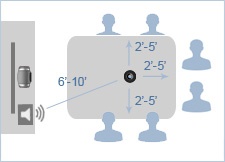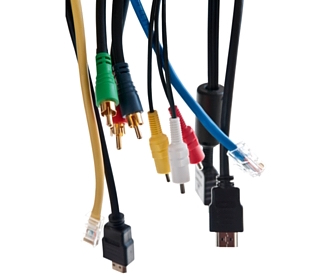Having a Great Video Conference
“Video Conferencing.” Words do matter.
Enterprise Video Conferencing is understood to provide IP Conferencing, where you initiate a call between two or more other IP Concerning systems. Brands like Polycom, Life-size and Cisco are common in this arena. IP stands for Internet Protocol; Its routing function enables internetworking and essentially establishes the Internet.
Soft Codec Video Conferencing is known to provide Cloud Based video conferencing like Skype, WebEx and Go-to-meeting. There is an exception to the rule here and that is that there are products that are primarily a Soft Codec Solutions but offer an IP Solution as an add-on. Many video conferencing solutions have been installed with the expectations of solving travel and collaboration issues.
Camera Position
The camera’s physical position will affect what the far site can see. Depending on how many people are in the meeting room, the camera will need to be a certain distance from the participants. For every participant in the room, the camera should be moved back about 2-3 feet. This will give you a portrait view of the participant(s). (Example: for 3 people, the camera should be at least 6 feet away. This will ensure all participants are within view of the camera.)
If you wish to have a broader/wider view, simply position the camera further back about 4-6 feet. This will give you a broader/wider (about half body shot) view of your environment. If longer, camera cables are required.
Microphone Position
Directional microphone :-
Directional mics are designed to pick up sound from a particular direction or side. We recommended placing the microphone at the edge of the table, pointing towards all the conference participants (the wired end should be pointing away from the participants). Try to place the microphone equidistant from all speakers in the room, while ensuring the capture side of the mic faces everyone without needing to be adjusted. If you are using multiple directional mics, each mic can be pointed at a subset of the conference participants. For example, with two mics, each mic can point to a different set of the people seated at a table.
Omni-directional microphone:-
Omni-directional microphones are designed to pick up sound from any direction. We recommend placing the microphone at the center of the table, equidistant from all participants in the room. Ideally, the microphone should be 5′-10′ away from the table top hub or external speakers. If you are using external speakers, avoid pointing them directly at the microphone.
Know Your Environment
When conducting a video conference session, any changes to the environment’s brightness or color will cause the camera to compensate. Try to avoid overpowering sources, such as:
Windows / Direct light – Windows should either be behind the videoconferencing system or be covered (blinds, window coverings, etc.). Having the camera pointed directly at a window or direct light source may cause the camera to overcompensate on white balance, brightness, and/or contrast. This provides an image with a bright background and a dark foreground.
Glossy/Mirrored surfaces – Any glossy or mirrored surfaces may affect the camera’s visibility. Depending on how light is reflected from the surface, this may cause unwanted distractions.
Environmental sounds – Avoid placing the microphone near or underneath devices that emit loud sounds. This can cause unwanted sounds during a session.
Choice of Clothing
The choice of clothing can also affect your video conferencing experience. “Busy” patterns on clothing, along with excessive motion may cause the camera to perform unwanted auto focusing. Fine stripe pattern can also produce a “moiré” effect. Bright colored clothing may cause the camera to dim your skin contrast. When possible, wear solid, neutral colors.
Room Control
Use the room AV equipment to give remote participants the best view of you and your meeting room. The room AV control can be used to move the camera, both at the start of the meeting and during. The chair of the meeting is sitting where the controls are and is best placed to change the camera as required; this is often when a speaker is ‘out of shot’. The controls can be used for muting the microphone.
Test Call
At times, meetings are required to connect to people and organisations outside SCU.
- It is vital that a test call be arranged to the destination of your videoconference in advance to ensure that there are no problems making a connection on the day.
- When booking an external videoconference, ensure you request a test call be organised.
About The Wireless
If you want to avoid the screeching sounds and don’t want to trip over cords during your presentation, you’ll want to use wireless microphones, speakers and wireless presentations. They allow you to move around the room at ease and engage the audience without you worrying about breaking a leg on stage.
You’ll also want to make sure your conference center choice has access to Wi-Fi so employees can tap into their phones or computers to receive emails or attachments you might send them during the conference.
We’d love To Meet You In Person Or Via The Web!
Main Office: Suite M-01, 512, 3rd Street, Abu Dhabi, UAE
Phone: + 971 2 6767019
WhatsApp: + 971 55 3979668
Email: web@OfficePlusUAE.com









